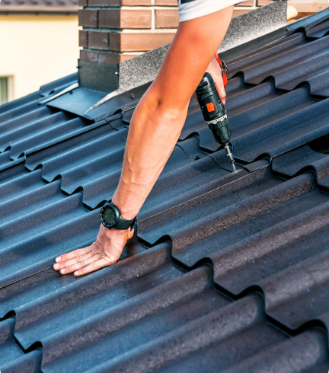Metal roofing is an increasingly popular choice among homeowners, as it provides a long-term, sustainable, lightweight, and cost-effective solution. But what are the components of metal roofing, and what do they do? This article will explain the different types of metal roof components and what each component does.
The Roof Deck
The roof deck is the base layer of a metal roofing system. It is made from corrugated galvanized steel or aluminum and serves as the structural base. It provides a solid surface to which other components, such as insulation, flashing, and metal roofing panels, can be installed. Not only does it provide structure, but it also prevents moisture from entering the home.
In some cases, a vapor retarder may be installed on top of the roof deck as an added layer of protection. This material helps reduce moisture penetration further and provides an extra layer of insulation.
The Flashing
Flashing is installed around edges and penetrations in the roof to prevent water infiltration. It is made from galvanized steel and is available in various sizes and shapes to fit different roof profiles. Flashing should be secured with corrosion-resistant screws, nails, or rivets and installed correctly to ensure it is properly sealed. It is important to note that flashing should have a minimum 4-inch overlap over the roofing panels.
For valleys and eaves, step flashing should be used. Step flashing consists of metal strips bent in an alternating pattern and installed beneath the shingles. This type of flashing is used to bridge the gap between roofing panels and create a waterproof seal.
The Ridge Cap
Ridge caps cover the peak at the ridge of a metal roof. They protect from rainwater and snow, adding an aesthetically pleasing finish to the roof. They are made of either metal or composite material and come in many different shapes, sizes, and colors to match the roofing materials used. The ridge cap also helps tie together the other components of the metal roof and ensures a secure, tight seal.
Additionally, ridge caps help provide additional protection from wind, dust, and debris. Finally, the ridge cap should be inspected regularly for wear or damage that could lead to water leakage or other problems. Proper maintenance of the ridge cap will help ensure a long-lasting roof.
The Fascia Board
The fascia board is the finishing trim on the roof. It runs along the roof’s edges and helps to ensure water does not get behind. The drip edge is placed directly behind the fascia board to ensure water runs off the roof instead of down into it. The fascia board is also where the gutters are attached to the roof. The board needs to be made of durable material, such as aluminum or steel, to hold up against the elements and ensure that it does not get damaged over time.
The fascia board can be decorated and painted to match the style of a home. This helps give an aesthetically pleasing look to the overall roof and makes it look more uniform.
The Underlayment
This layer of protection is installed directly over the roof deck. It is a water-resistant or waterproof barrier that helps to keep moisture from entering the house and damaging it over time. Underlayment also helps to provide extra insulation. It can be synthetic or felt paper. Synthetic underlayment is most commonly used because it lasts longer, is more durable, and provides better protection from water. The felt paper underlayment is generally used in areas with lower precipitation levels or if a homeowner wants an extra layer of protection. The felt paper should be laid in strips, overlapping each other as applied. This helps to create even coverage and ensures water will not seep through the gaps.
Metal Panels
The metal panels on a metal roof are its primary weatherproofing barrier. They are typically manufactured in long, narrow strips to cover the entire roof from ridge to eave. The panels can be cut and formed into shapes that fit your roof’s angles, curves, and dimensions. Metal panels come in various materials, such as aluminum, steel, copper, or zinc alloys. They can be finished with various coatings, such as paint or textured finishes.
Fasteners and Clips
Metal roof fasteners are used to secure the roof panels and other components. Common fasteners include screws, nails, bolts, and clips. Fasteners are designed to be installed in a specific way, depending on the type of metal roof panel being used. For example, screws and bolts are typically inserted at the top and bottom of the panel, while nails are inserted along the sides. Fasteners should be appropriately installed to attach the roof to the structure securely.
Clips are an important part of the metal roof installation and provide a secure connection between two pieces of metal. The clips are typically inserted along the panels’ sides and will help keep them in place during strong winds or extreme weather conditions. It is important to choose fasteners designed to be used with a specific type of metal roofing material. Using the incorrect fasteners can lead to leaks or other damage over time. Properly installed fasteners will help to ensure that your metal roof lasts many years.
The components of a metal roof are essential for ensuring its longevity. Each component is important for creating a secure and weatherproof roof, from the fascia board to the underlayment, fasteners, and clips. You should work with a reputable roofing company like Big Rock KangaROOF to ensure your metal roof is installed correctly and lasts many years. We can help you with all of your residential roofing needs, storm damage restoration, and emergency roof repair in Central, AR. Contact Big Rock KangaROOF today for a free estimate!
